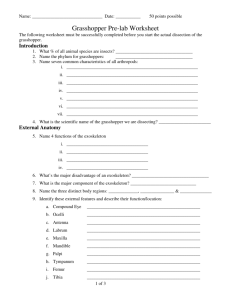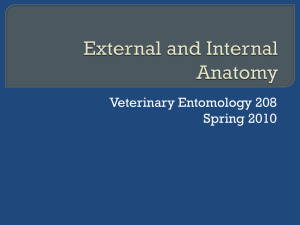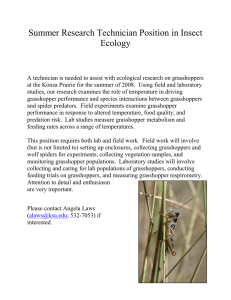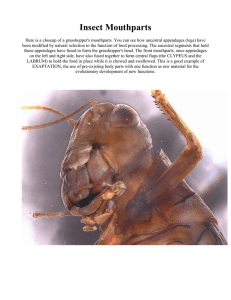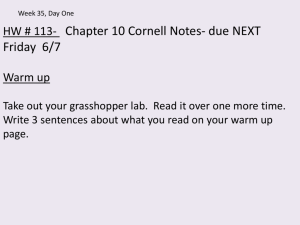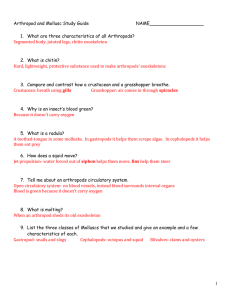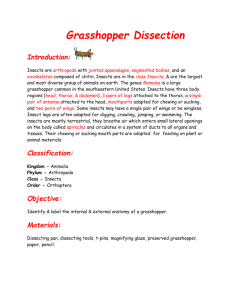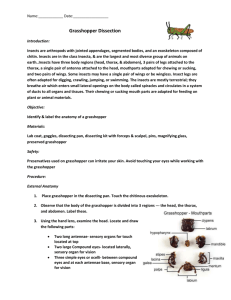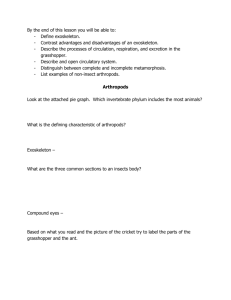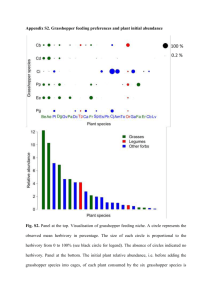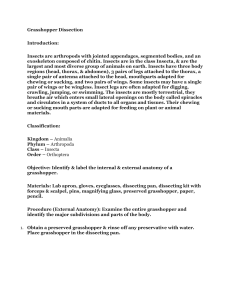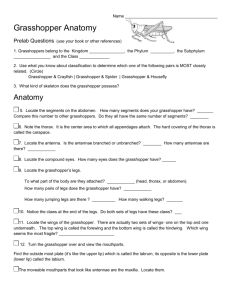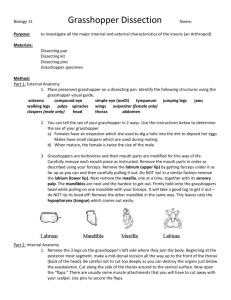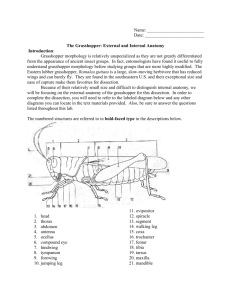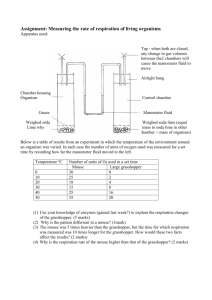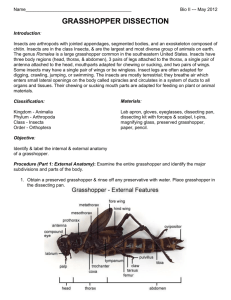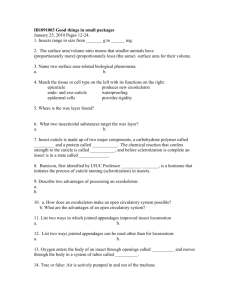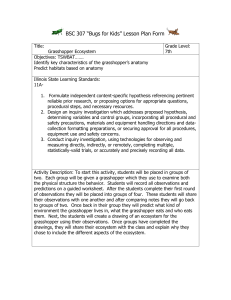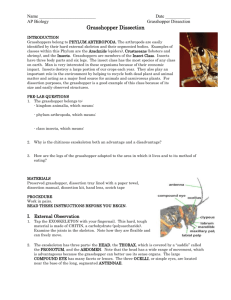Grasshopper Prelab Information taylor
advertisement
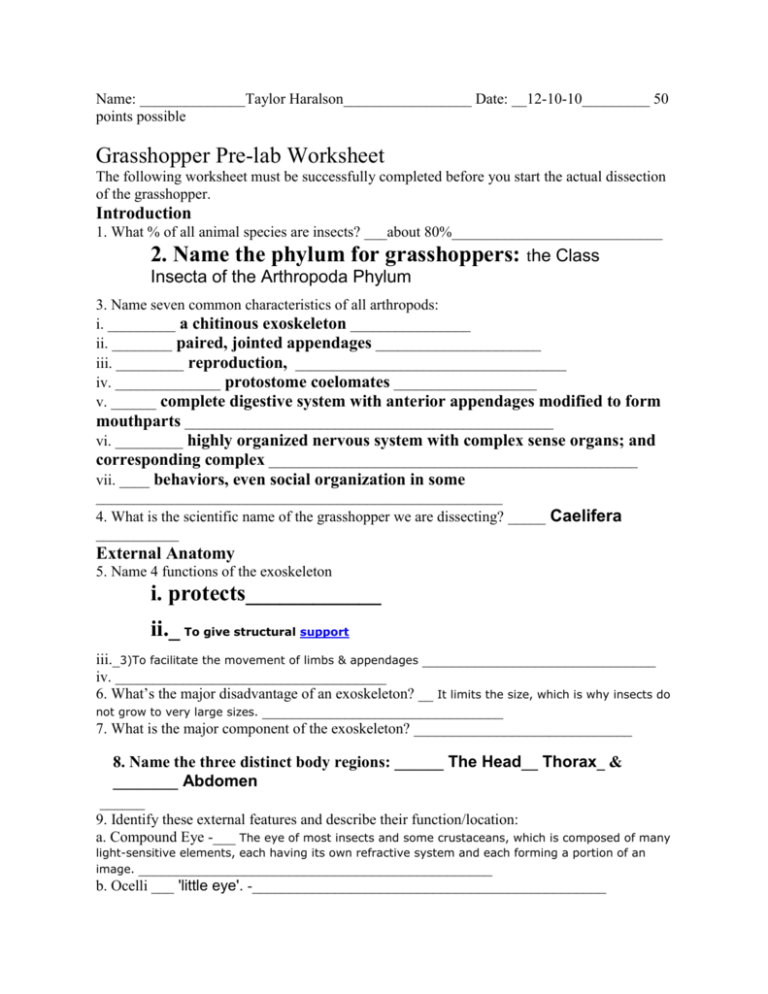
Name: ______________Taylor Haralson_________________ Date: __12-10-10_________ 50 points possible Grasshopper Pre-lab Worksheet The following worksheet must be successfully completed before you start the actual dissection of the grasshopper. Introduction 1. What % of all animal species are insects? ___about 80%____________________________ 2. Name the phylum for grasshoppers: the Class Insecta of the Arthropoda Phylum 3. Name seven common characteristics of all arthropods: i. _________ a chitinous exoskeleton ________________ ii. ________ paired, jointed appendages ______________________ iii. _________ reproduction, ____________________________________ iv. ______________ protostome coelomates ___________________ v. ______ complete digestive system with anterior appendages modified to form mouthparts _________________________________________________ vi. _________ highly organized nervous system with complex sense organs; and corresponding complex _________________________________________________ vii. ____ behaviors, even social organization in some ______________________________________________________ 4. What is the scientific name of the grasshopper we are dissecting? _____ Caelifera ___________ External Anatomy 5. Name 4 functions of the exoskeleton i. protects____________ ii._ To give structural support iii._3)To facilitate the movement of limbs & appendages _______________________________ iv. ____________________________________ 6. What’s the major disadvantage of an exoskeleton? __ It limits the size, which is why insects do not grow to very large sizes. ________________________________ 7. What is the major component of the exoskeleton? _____________________________ 8. Name the three distinct body regions: ______ The Head__ Thorax_ & ________ Abdomen ______ 9. Identify these external features and describe their function/location: a. Compound Eye -___ The eye of most insects and some crustaceans, which is composed of many light-sensitive elements, each having its own refractive system and each forming a portion of an image. _______________________________________________ b. Ocelli ___ 'little eye'. -_______________________________________________ c. Antenna ____- one of a pair of mobile appendages on the head__ d. Labrum _- a lip or liplike part. _________________________________________________ e. Maxilla ___ a jaw or jawbone _______________________________________________ f. Mandible __ the bone of the lower jaw. _________________________ g. Palpi ___ an appendage attached to an oral part and serving as an organ of sense in insects _______________________________________________ h. Tympanum ___ the stretched membrane forming a drumhead. __________________ i. Femur _____ one in the human leg extending from the pelvis to the knee j. Tibia __ the inner of the two bones of the leg_ __ Name: __Taylor Haralson _____________________________ Date: ___________ 50 points possible 2 of 3 k. Tarsus _ the bones of the proximal segment of the foot l. Spiracles ____ a breathing hole ______________________________________________ m. Ovipositor ______ an organ at the end of the abdomen The Head 11. How many segments is the head actually made up from? ____ 3: the vertex, the occiput, and the fastigium. __________________ 12. Food is manipulated by what “tongue-like” organ? _________________________________ 13. What are the types of eyes? ______ compound ____ and ____simple_____________________ 14. What antenna are sensory structures for which two senses? ____________ & _____________ The Thorax 15. How many segments is the thorax made from? ____________________ 16. How many joints/segments does each leg have? __________________ 17. What structure is used by the male to produce mating calls? ___________________________ The Abdomen 18. How many segments is the abdomen made from? ______________________ 19. What is the female egg laying structure called?______________________________________ Respiratory System 20. What is the respiratory system of the grasshopper called? _____________ spiracles _______________ 21. What is the series of tubes used to distribute the air called?_____________________________ 22. The Tracheal System begins w/ ________breathing___________________ 23. Can Grasshoppers pump air into the spiracles? __no______________________ Name: _____taylor haralson__________________________ Date: ___________ 50 points possible Digestive System 24. Food is chewed up into smaller pieces and then moistened by ________________ mandibles _________ 25. What muscular organ manipulates the food for swallowing? tongue 26. Describe the path of food thru the digestive system: a. Mouth, __ pharynx, ____ esophagus ___, _____ stomach ____ cardiac sphincter ____, ____ small intestine, ____ ileocecal valve, ___ large intestine or colon, __, ______ rectum ________, _______________, ________________ and anus. The __________________ secrete digestive enzymes into the stomach. Circulatory System 27. What type of circulatory system does the grasshopper have? open circulatory system Excretory System 28. What organs are used to remove nitrogenous wastes (urea)? ___ The excretory system ___________________ Nervous System 29. How many ganglions does the grasshopper brain have? ________________ 30. Does it have a dorsal or ventral nerve cord? ____ Grasshoppers have a nerve ladder down the ventral surface of their belly Reproductive System 31. How do you tell the difference between the sexes? ____________________________________ On the underside of the grasshopper, the female will have a pointed and long segment at the end of her body. The male will have a rounded segment that is not pointy and long at the end of his body. ________________________________________ ____________________________________________________________________________
